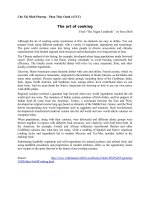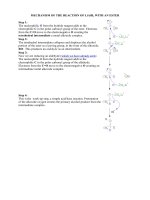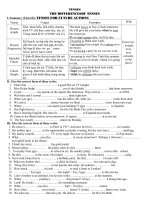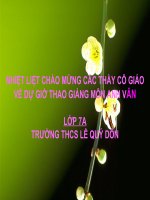Christian Dior.The magic of fashion
Bạn đang xem bản rút gọn của tài liệu. Xem và tải ngay bản đầy đủ của tài liệu tại đây (15.23 MB, 66 trang )
Presented by the Powerhouse Museum in association
with Christian Dior, Paris and
the Union Francaise des Arts du Costume, Paris
PUBLICATION
Design: MaD House Design
Editing: Meryl Potter
Translations: Joanna Savill (Genty, Ferre,
exhibition catalogue listing) and Diana
Mitchell (Kamitsis)
Photography: Sue Stafford*
Production coordination: Julie Donaldson*
Copyright: Dallas Cox*
Word processing: Anne Slam*
Printing: Bloxham & Chambers
Published in conjunction with the
exhibition Christian Dior: the magic of fashion
at the Powerhouse Museum
27 July-23 October 1994.
EXHIBITION
Project director: Jane de Teliga*
Curators: Louise Mitchell*; Marika Genty
(Christian Dior); Lydia Kamitsis (UFAC);
Glynis Jones*
Design: Susan Freeman*
Coordination: Susan McMunn*
Graphic design: Colin Rowan*
Conservation: Suzanne Chee*
Audiovisual: Kathleen Phillips*
Editing: Karin Vesk*
* Powerhouse Museum staff
ACKNOWLEDGMENTS
The Powerhouse Museum gratefully
acknowledges the assistance of the
following: Judy Barraclough; Mrs Marjorie
Birch; Nicole Bunbury; June Dally-
Watkins; Patricia Harewood; Beril Jents;
Sandra King; Paule Paulus; Sheila Scotter;
Wolfgang Sievers; Rosemary Spittle; Mrs
Sam Wood. Thanks also to: Edwina
Baillieu; Sam Griffin; Michael Shmith;
Georgina Weir; Joan Wreford.
Colleagues and institutions in Australia:
Australian Film and Sound Archive, Annie
Vass; Australian National Gallery, Michael
Desmond, Roger Leong and Gael Newton;
Coles Myer Ltd archives, Stella Barber and
Angela Henrickson; David Jones Ltd
archives, Barbara Horton; National Gallery
of Victoria, Isobel Crombie, Robyn Healy
and Susan van Wyck; University of
Queensland, Margaret Maynard.
CIP
Dior, Christian
Christian Dior: the magic of fashion.
Bibliography.
ISBN 1 86317 048 0
1. Dior, Christian — Exhibitions. 2. Fashion designers — France
— History — 20th century — Exhibitions. 3. Fashion — France
— Paris — History — 20th century — Exhibitions. 4. Fashion —
Australia — History — 20th century — Exhibitions. 5. Costume
design — France — History — 20th century — Exhibitions. I.
Powerhouse Museum II. Title.
746.92092
© 1994 Trustees Powerhouse Museum, Sydney.
This publication is copyright. Apart from any fair dealing for the
purpose of study, research, criticism or review, or as otherwise
permitted under the Copyright Act, no part may be reproduced by
any process without written permission from the Powerhouse
Museum.
First published 1994
by Powerhouse Publishing
PO Box K346,
Haymarket
2000 NSW Australia
Every effort has been made to contact the copyright owners of and
provide correct acknowledgment for the photographs reproduced in
this publication. All inquiries should be made to Powerhouse
Publishing.
Forewords
by Terence Measham, director Powerhouse Museum
Bernard Arnault, president Christian Dior
Pierre Berge, president UFAC
4
4
5
The House of Dior today
by Gianfranco Ferre
Christian Dior: the magic of fashion
introduction by Louise Mitchell
8
Couture and elegance: the House of Christian Dior 13
by Marika Genty
Christian Dior: a new era in haute couture 26
by Lydia Kamitsis
Christian Dior and postwar Australia
by Louise Mitchell
Chronology: the Dior years 1946 — 1994
compiled by Marika Genty
Catalogue of the exhibition
Further reading
Photo credits
38
54
58
64
64
6
he Powerhouse Museum is delighted to
be presenting the exhibition Christian Dior:
the magic of fashion in association with
Christian Dior, Paris and the Union
Francaise des Arts du Costume (UFAC).
Christian Dior is undoubtedly the most
famous name in twentieth century fashion.
The Powerhouse Museum, which holds one
of Australia's foremost collections of
costume, is proud to stage this major retro-
spective of Dior. This is the first time such
a significant collection of Dior gowns has
been displayed outside Paris.
Drawn from the collections of Christian
Dior and UFAC, the exhibition traces the
remarkable decade of design by Christian
Dior from 1947 to 1957 and brings it to
the present with a selection of gowns by the
House of Dior's later designers, Yves Saint
Laurent, Marc Bohan and Gianfranco
Ferre. A special section developed by the
Powerhouse Museum focuses on Dior in
postwar Australia, in particular the Dior
parades held at David Jones in Sydney in
1948 and 1957.
The Powerhouse Museum is grateful for
the cooperation of Christian Dior, Paris and
the assistance of Michel-Henri Carriol,
delegate for Christian Dior in Australia, in
enabling this important exhibition to come
to Australia.
I would also like to acknowledge the
collaboration of the curators of the
exhibition: Louise Mitchell, from the
Powerhouse Museum, who worked on the
exhibition in association with Marika Genty
from Christian Dior and Lydia Kamitsis
from UFAC; and Jane de Teliga who
initiated and directed the project for the
Powerhouse Museum.
Our grateful thanks go to all those who
have generously supported the Christian
Dior exhibition, particularly the following
sponsors:
Air France • Union des Assurances de Paris
• Parfums Christian Dior • Nine Network
Australia • David Jones Australia • Hotel
Inter- Continental.
Terence Measham
Director, Powerhouse Museum, Sydney
hristian Dior — the magical name that
for forty-seven years now has been
synonymous the world over with the
enchantment of French fashion, elegance
and style.
Regardless of the intrinsically
fleeting nature of this creative sphere
and the endless cycle of seasonal collec-
tions, the House of Christian Dior has
somehow withstood the cruelty of
time: season after season, Dior has,
almost paradoxically, built its own
timelessness, eschewing the ephemeral
and placing itself squarely in the realm
of tradition.
4
Despite the untimely death of its
founder, the House of Dior has grown and
branched out beyond its original field, that
of haute couture, to acquire the far more
global dimension it enjoys today.
I am always moved when I re-read the
visionary words taken from Monsieur
Dior's personal correspondence: 'In
troubled times like ours, we must uphold
our tradition of luxury, the jewel of our
culture.'
Bernard Arnault
President, Christian Dior
hristian Dior did not invent haute
couture, but it was incontestably he who
fixed its rules and set its bounds. Thanks to
him, fashion became an art form in France
and is now part of our national heritage. He
invented licensing, and his name, famous
throughout the world, has become
synonymous with elegance and creativity.
His reign was to last only ten years
(1947—1957), but he made his mark in such
a way that even today it has lost nothing of
its magic.
In 1955 Dior discovered the talent of a
young man as yet unheard of, Yves Saint
Laurent. He took him on, made him his
closest assistant and then his avowed
successor. At the beginning of their collab-
oration, Yves Saint Laurent created a dress,
photographed by Richard Avedon for
Harper's Bazaar on 30 August 1955 in the
now famous composition 'Dovima and the
elephants'. It was therefore quite natural,
when Dior died in 1957, that Yves Saint
Laurent should succeed him.
The Union Francaise des Arts du
Costume (UFAC), which came into being in
1948, a year after the Dior adventure began,
set itself the task of perpetuating French
creativity.
UFAC has been able to preserve
thousands of pieces of clothing, providing
us today with a broad view of creative
fashion history. Our collections of clothes
and documentary resources make up one of
the world's biggest reference centres,
which designers continue to add to, season
after season. As its custodian, UFAC has
made this heritage available for nearly fifty
years by taking part in international events
like Christian Dior: the magic of fashion at the
Powerhouse Museum in Sydney.
I trust that this exhibition in Australia
will give a broad public the opportunity to
admire some of the most original and inter-
esting works of art of our times, and to
appreciate the emergence, two years alter
the end of the Second World War, of a
designer whose name would resound like
thunder down the decades.
Pierre Berge
President, Yves Saint Laurent
President, the Union Francaise des Arts du
Costume, Paris
5
The artists I admire are those who try to unleash a certain
interplay in their work, creating within the parameters of
tradition and innovation.
When I came to Dior my initial concern was to bring into
contemporary focus what was generally considered to be a
magical universe. By using trousers, for example, a fairly
masculine garment, I was able to revive the classic Dior suit.
Combined with a waisted jacket, highlighted by a blouse in
organza or lace, they create the sort of shape I really like:
something that is both romantic and contemporary, but remains extremely feminine.
Everything Christian Dior produced works on this basic polarity between strength and
softness, tradition and innovation. He could put together a collection featuring a gown with
the purest of lines alongside one sprinkled with mock daisies, in a trompe l'oeil effect. In the
same vein, he would blend artificial forms with traditional materials and inject an air of
modernity into every one of his designs.
That's my point of departure too. When designing my own collections I am constantly
reworking the theme of contrasts.
There are many links between my work and that of Christian Dior. As a former architect I
am accustomed to developing my designs in two steps, starting from research and experi-
mentation and making free, flowing sketches. I concur with Christian Dior's words when he
said: 'Sketches are the first form of an idea.'
1
They are the expression of a look, a line, a
stance. They are a guide to volume and proportion. I create moving shapes and lines.
The next phase is pure technique, the architectural plan as it were, where the fabric of
the design takes on volume and form.
The expertise of the Dior workrooms, heirs to the full tradition of couture, means the
professional skills and techniques of the past can be applied to the present. Thanks to their
skills, I can conjugate and decline lines, shapes and collections adapted to today's woman.
Together we develop clothing combinations that allow a woman to feel elegant, confident
and highly individual.
To perpetuate the spirit of Dior is to create pure, precisely drawn lines, with defined,
perfectly balanced volume, and then underline them with amazing cutting techniques.
Playing with the masculine-feminine also follows the Dior image — the use, for example,
of harsher fabrics, like Prince of Wales and hound's-tooth checks. I go beyond the historic
6
'Alcove' an evening ensemble
designed by Gianfranco Ferre
for the House of Dior,
Autumn-Winter collection
1993-94. The rich colours
and motifs of the East inspired
this dramatic outfit, made in
an unusual combination of
mohair and organza.
trademarks of the House of Dior, but by doing so I also reinforce them, using the
counterplay of colours like the notes of an organ, an exchange between the contrasts of black
and white or the subtler shades of beige and grey.
This return to the source allows me to re-centre, purify or elaborate on my designs as my
instinct dictates, and then to re-create a 'truly Dior universe' in conjunction with the staff of
this prestigious establishment.
'I have been seduced by this marvellous instrument — Dior's workrooms, design teams
and his image. It's as if I had been given a Stradivarius to play on entirely as I wished.'
2
* Gianfranco Ferre is Creator of the Haute Couture, Haute Fourrure (Haute Couture Furs), Women's Pret-a-
Porter and Pret-a-Porter Furs at Christian Dior.
1. Elie Rabourdin and Alice Chavanne, eds. Je suis couturier (I am a couturier), by Christian Dior, Editions
du Conquistador, Paris, 1951, p62. 2. Gianfranco Ferre, cited by Francois Baudot, 'Gianfranco Ferre',
L'Officiel de la Couture, April 1989, p1 82.
7
Throughout the history of French decorative arts and design, there has been a complex
relationship between the continuity of French tradition and the spirit of innovation and
change. In both form and function, a dialogue has been maintained between innovation and
tradition that has given French decorative arts their distinctive appearance and unique
history. The success story of Christian Dior and his couture house is representative of this
theme in French design.
Before the French Revolution the court was the focal point of the creation and dissemi-
nation of style in matters of dress. Traditional values inherited from the ancient regime —
fine crafting, respect for luxury materials, and refinement of detail and finish — were
integrated into the expanding luxury industries that flourished in nineteenth-century France.
After the role of the couturier emerged during the Second Empire (1852—1870), haute
couture became stamped on the international consciousness as typically French. The
standards of creativity and skill set by designers such as the Callot Soeurs, Poiret, Chanel,
Vionnet and Balenciaga in the first half of the twentieth century reinforced Paris's role as the
undisputed centre of fashion. By the time of the Second World War, haute couture had
proved its monetary and cultural value for France.
Recognition of haute couture's worth as a symbol for France helped set the scene for
Christian Dior's extraordinary success when he launched his house in the years immediately
after the war. With a disregard for postwar rationing and a conscious effort to revive the
spirit of the luxurious fashions of the Second Empire and the belle epoque, Dior brought
excitement back to fashion and revived haute couture. In doing so, he demonstrated not only
an outstanding flair for dress design, but also a shrewd understanding of French tradition in
the decorative arts and its significance to markets abroad.
The exhibition Christian Dior: the magic of fashion is primarily a retrospective of Dior's
decade of achievement as the most authoritative figure in the world of fashion. It begins with
the 'Bar' suit of 1947, an outfit that encapsulates the New Look, which was to make Dior a
household name. It continues with over sixty garments that represent his seasonal collections
up to the time of his death in 1957. The exhibition concludes with designs by Dior's
successors at the House of Dior: Yves Saint Laurent, Marc Bohan and the present designer,
the Italian Gianfranco Ferre. Extending the exhibition up to the present shows the continuity
of the Dior tradition and house style.
A publication like this is an opportunity to expand on exhibition themes. The exhibition's
storyline was developed by the major lenders, Christian Dior archives and the Union
8
Henry Clark's 1956 photograph
of the mannequin Dovima
wearing a Dior hat encapsu-
lates the glamour and elegance
of the Dior style and evokes
nostalgia for a past age
of luxury and good taste to
which Dior aspired.
Francaise des Arts du Costume (UFAC). The French curators, Marika Genty from the House
of Dior and Lydia Kamitsis from UFAC, have highlighted Dior's approach to design in terms
of seasonal changes in silhouettes, cut and construction, as well as in the use of opulent
fabric embellishments, such as embroidery, that reveal the dazzling technical skills of the
Parisian workrooms.
A major section of the exhibition, entitled 'The Dior wardrobe', categorises clothes
according to time of day and purpose, which again highlights the tradition of couture
recalling court etiquette. The essays by curators Marika Genty and Lydia Kamitsis provide
the background to the exhibition approach. Gianfranco Ferre in his essay acknowledges the
interplay of tradition and innovation in his collections for the House of Dior and gives credit
to the workrooms that realise his designs.
My own contribution has been to look at the influence that French fashion, particularly
that of Christian Dior, had in Australia in the postwar years. Because of its relevance to a local
audience, a section about the Australian response has been included in the exhibition. Only a
year after the New Look was launched, Sydney had the opportunity to view a collection of
Dior garments, billed as the first collection to be seen outside France. The collection was
shown at David Jones department store in Sydney, one of the many stores around the country
9
Fashion illustration of Dior's
'Isphahan' ball gown by Rene
Gruau, 1947. Illustrators and
photographers played an important
part in interpreting and dissemi-
nating the look and mood of Dior's
latest collections. By creating
a fantasy world around the dress
they added to its desirability.
that had considerable interest in promoting French fashion to the Australian buyer. The late
1940s and 1950s was a time of intense interest in Paris fashion, and it was a period when the
moderately priced market was flooded with fashion derivative of Paris.
At the heart of Dior's success was his ability to combine the seemingly inconsistent areas
of exclusive design and mass merchandising. Christian Dior's business acumen ensured that
his house reaped considerable benefits from cooperation with department stores the world
over and from his being the first couturier to develop a licensing system. As Lydia Kamitsis
points out in her essay, Dior founded a fashion empire on a past that took its strongest guide-
lines from the traditions of French art de vivre, whilst summoning a new era of couture in
which underwriting by the mass market ensured the continuation of the unique and
expensive handmade designs of the couturier.
* Louise Mitchell is a curator of Decorative Arts and Design at the Powerhouse Museum, Sydney.
10
Dior mannequins in 1957. For each collection Dior presented about 1 70 garments in a show
lasting up to two hours. The order of each show was carefully set, beginning with suits,
then formal town dresses, then more formal outfits, cocktail dresses, short evening dresses,
and long evening dresses and ball gowns. The finale would be the wedding dress.
Photo by Loomis Dean, Life
Magazine,
1957.
11
House
of
Christian
Dior
'Far from wanting to revolutionise fashion I only wanted to dress the most elegant
women, from the most elegant ranks of society.'
1
Such boldness from one so timid was enough to convince industrialist Marcel Boussac when
Christian Dior came to him with his plan: to create a fashion house under his own name,
something 'small and secluded, with very few workrooms; within them the work would be
done according to the highest traditions of haute couture; and would be aimed at a clientele of
really elegant women'.
2
It would produce only clothes 'which would give an impression of
simplicity, [but] would in fact involve elaborate workmanship'
3
to cater to markets abroad. The
die was cast, and on 8 October 1946 the Societe Christian Dior was formed.
But just who was the man behind the name Christian Dior? Born in 1905 at Granville in
Normandy, Christian Dior did not come to the world of fashion until the age of thirty, after
Opposite: 'Curacao', from the 1954 Autumn - Winter collection, known as the
H-line. Dior's intention was to create an elongated, youthful line by pushing up
the bust and dropping the waist to the hip. The press dubbed it the String Bean
or Flat Look, mistaking the high bustline for no bust. Photo by Henry Clarke.
13
Each season Dior presented a
collection of the most dramatic
and feminine evening gowns.
'Junon' (Juno) was part of his
Milieu du siecle (Mid-century)
collection of 1949, which referred
to the crinoline dresses of the
mid-1800s. Photo by Horst.
Opposite: Some of Dior's most
beautiful dresses featured
elaborate floral embroidery. In
'Vilmorin' (detail shown), from
the Spring-Summer 1952
collection, delicate daisies seem
to grow from the white organza
ground. Photo by Sacha.
originally training for a diplomatic career, setting up an art gallery and travelling widely
outside France. He worked briefly as a fashion illustrator, but from 1938 to the declaration
of the Second World War he was employed as an assistant to couturier Robert Piguet, and
then became a junior designer for Lucien Lelong. At Lelong's he learned a sense of fabric,
honed his creative talents and observed the workings of a major fashion house.
In 1946 he left Lelong and set up his own premises at 30 avenue Montaigne in 'an
attractive dwelling with [a] classical and Parisian elegance. I was determined that my
decor should not degenerate into elaborate decorations and distract the eye from my
clothes.'
4
The pearl grey and white Louis XVI decor he knew from his childhood was
perfectly in tune with the atmosphere at his establishment and, in its characteristic elegance,
contributed to the famous Dior look.
Such surrounds demanded 'a staff of great class',
5
rigorously handpicked by Christian
Dior. His gift lay in his choice of the best employees who, along with the clout of Marcel
Boussac, allowed him to develop the quality he strove for as 'a conscientious craftsman'
6
and
gave free rein to his imagination.
14
ensure the smooth running of the fashion
parade, Dior drew up charts containing the
name and number of each dress, a fabric
sample, and brief descriptions and details of
all the accessories. Photo by Loomis Dean,
Life
Magazine, about 1957.
Opposite: Dior relied on his technical director,
Marguerite Carre, to oversee the translation of
his sketches into clothes. Each workroom, under
the leadership of a skilled head, was assigned a
number of dresses to complete. In the
background of this photograph are dress forms,
which were made to the measurements
of each client. Photo by Bellini.
Christian Dior's first collection was unveiled to le Tout Paris (the cream of Parisian
society) on 12 February 1947, amid great excitement. It was received with 'a hurricane of
applause'. 'It's quite a revolution, dear Christian,' said Carmel Snow, chief editor of Harper's
Bazaar, uttering her famous phrase: 'Your dresses have such a new look. They are wonderful,
you know.'
7
And so the New Look, as the first Dior collection came to be known, was born.
Deliberately turning his back on the military style so favoured in the 1940s, Christian
Dior revived the feminine look, with clothes that were all soft curves. His dresses empha-
sised the breasts, featured little rounded shoulders and a nipped-in waist, flaring at the hips
into a straight or flowing skirt that dropped to below calf length. These were the new lines a
la Dior, typified in his 'Bar' suit.
An afternoon dress could take anything from 3 to 40 metres of fabric: 40 metres of faille
were used to make 'Cherie'. This abundance of fabric signalled the end of postwar restraint
and heralded the kind of fashion women hungered for, and this was the key to the enormous
success of the New Look.
On the other side of the Atlantic, however, department stores reacted with hostility after
16
their orders of Dior gowns sold out in the space of twenty-four hours. Alliances were
formed to defend short skirts, and Dior was accused of 'disfiguring' women. Only the
strenuous efforts of the fashion editors saved the day, by convincing the buyers to go back to
Paris. By the end of 1947 America had been conquered, and Nieman Marcus in Dallas
awarded Christian Dior the Oscar of Haute Couture in recognition of the new life he had
breathed into fashion.
Orders began to mount up and, to cope with the demand, two new workrooms were
added to the three Dior had started with. The second collection was even more successful
than the first.
The next step was to expand and take advantage of the Christian Dior name: why not
create accessories to his designs, articles like perfume, furs, hats, stockings, gloves, shoes
and jewellery? Not even the slightest detail of elegance was to be ignored. Christian Dior's
dream was now realised: to dress women 'from head to foot',
8
right down to their
underwear.
In order to satisfy Dior's desire to provide a complete wardrobe, a whole network sprang
17
'Favori' (Favourite), from Dior's
Oblique line, was shown in his
Autumn-Winter 1950 collection.
The tie scarf wrapped across
the body and was cinched under
the belt, giving the suit a
dynamic asymmetrical line.
Photo by Irving Penn.
Opposite: For Dior, line,
shape and proportion were
most important, as seen in the
dramatic silhouette of the
'Cocotte' (Sweetie) suit from his
Spring-Summer 1948 collection.
Photo by Coffin, 1948.
up around the central hub. Jacques Rouet, Dior's administrative manager and financier, soon
put in place a system for manufacture under licence to the name Christian Dior. Licensing
contracts were signed with department stores in Australia, Canada, Cuba, Chile and Mexico.
From the earliest days of the couture house, the name of Christian Dior extended its
influence beyond its native borders. In 1948 Christian Dior opened boutiques in New York
and Caracas, and another followed in London in 1954.
With twenty-eight workrooms by 1954 the Dior empire was flourishing. The future was
bright. But every season demanded new designs to surprise his two to three thousand clients
and inspire them to renew their Christian Dior wardrobes.
Names of lines like Zig-Zag, Envoi (Flight), Cyclone, Moulins a Vent (Windmills) or Ciseaux
(Scissors) not only created an image in the public's mind, but also made movement the focus
of each collection. Dior's whirlwind pleated dresses gave life and youth to the form, trans-
forming the wearer into a flower. The Z-shape formed by the folds of a gown recalled the
flighty strokes of a pencil sketch. The impression of flight with every step came from an
unequal distribution of the fullness of the skirt of a dress.
18
crossover, asymmetrical effect — to assiduous followers of the seasonal collections these
were the details of the broad direction in which Christian Dior was moving, keeping the
New Look well and truly alive.
But were these details and seasonal changes enough to entice women to wear Dior? They
were also invited to dream a little with embroidered gowns rich in Persian-inspired motifs
and equal to the finest pieces of jewellery. And tempted to reconsider the charms of a rustic
ball with dresses sewn with daisies, currants or dragonflies. Creating an embossed effect,
creating texture with lace, braid or jet— anything to fuel women's imaginations.
Each collection was a cunningly orchestrated coup de theatre: by constantly coming up
with something new Dior ensured maximum publicity for every collection.
After the wasp waist and oversized full skirts, Christian Dior realised that women wanted
clothes that were in tune with the demands of daily life. He moved away from the New Look
and onto collections dominated by geometric lines. In the 1950s the words 'vertical',
'oblique', 'oval' and 'long' came up time and time again, suggesting a stylisation of the
female figure. But the culmination of Dior's geometric lines were the H, A and Y designs.
The H-line, created for the 1954 Autumn-Winter collection, essentially lengthened and
streamlined the torso to create a half-girl/half-woman effect. The dresses, suits and coats
were cut along parallel lines like the letter H. The Flat Look or Haricot Vert (String Bean),
as the fashion media dubbed them, seemed to flatten the chest — arousing a great deal of
criticism and controversy.
The shape symbolised by the letter A, introduced in the Spring-Summer collection of
1955, was similar in construction to the H-line, but was based on two joining diagonals. The
dominant effect was once again a longer torso, while the crossbar of the A, representing the
waist, was more mobile.
The Y-line of the 1955 Autumn-Winter collection was a reaction against long basques and
dropped waists. In this collection the two upward strokes of the Y formed a wide, high
bustline. The waist was tightly nipped in and placed higher than usual, giving an extra length
to the skirt, and therefore also to the legs. The key element in Dior's letter collections was
the variation in waistlines.
But closer to Dior's heart than the latest novelty was his desire to meet the needs of his
elegant clientele. He developed a system of chartes (charts) to ensure balance in the collec-
tions and to give an overview of the types of garments each one featured. These large sheets
of paper (measuring 24 x 1 9 inches) were pinned to the wall or placed on the floor of his
studio and detailed every item in the collection, from suits to evening wear, in thirteen
different categories. A fabric sample for each garment was attached, along with any relevant
20
For Dior the hat was an indispensable part of the total look, complementing the
proportions and line of the dress. He spent many hours designing and selecting hats for each
of his outfits, and his hat styles came to be as influential as his clothes.
Photo by Louise Dahl-Wolfe, 1953.
21
Right: On the day of the showing of a
new collection, chaos reigned as
dressers, mannequins, hairdressers and
workroom heads crowded into the
dressing-rooms. For Dior,
this was the moment when the
collection passed out of his hands into
those of the mannequins. Here the
mannequin is being dressed
in 'May', an evening gown from Dior's
Spring-Summer 1953 collection.
Photo by Henri Cartier-Bresson, 1953.
Left: Seamstresses at work at Maison
Dior. When Dior set up his house he
carefully handpicked his staff, aiming for
a mix of technical expertise with inspira-
tional flair. His seamstresses in
particular had to be technically very
skilled: each dress was constructed on a
foundation, and, instead of using darts,
Dior insisted that they mould the fabric
to shape with hot irons.
Photo by Bellini.
22
Presented in his Envoi (Flight) collection of 1948, Dior considered the 'Adelaide' evening
gown his masterpiece. With 70 metres of tulle in the skirt alone the dress embodies
the femininity, luxury and extravagance of Dior's New Look and marks the end of wartime
restraint. It was shown at the Dior parade in Sydney in 1948. Photo by Coffin, 1948.
23









